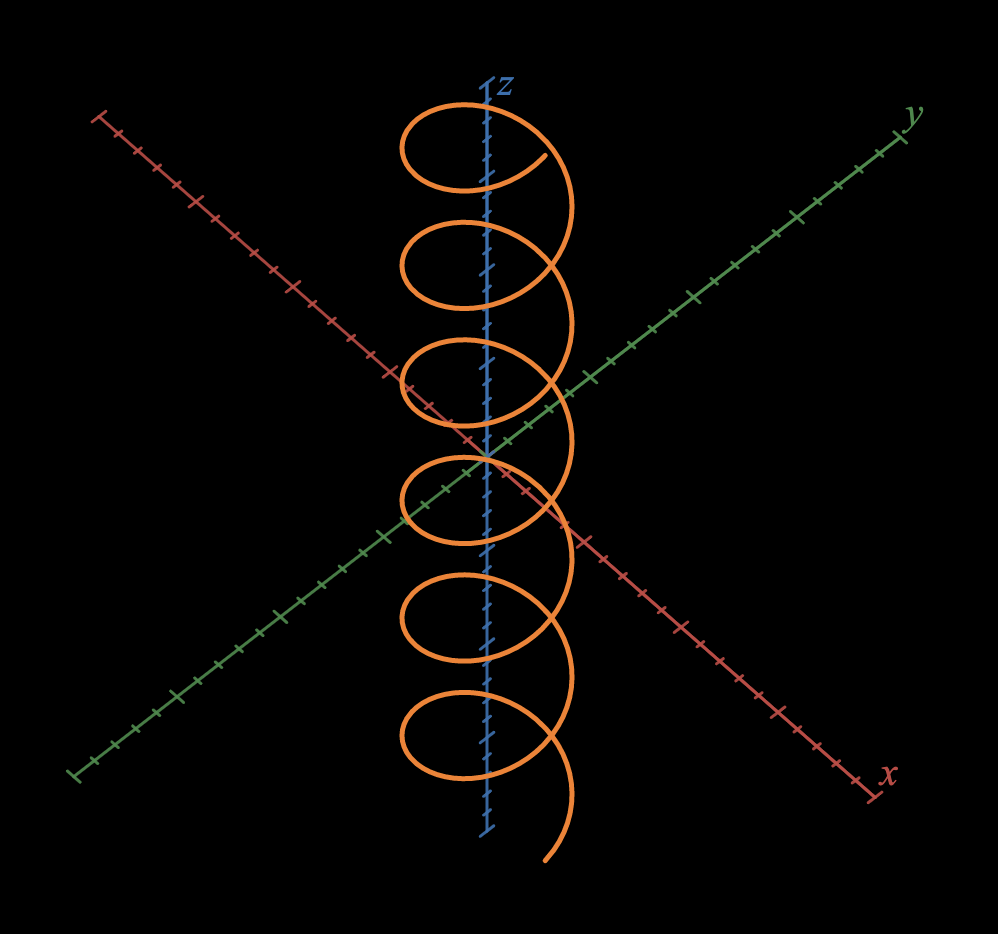Vector functions and space curves
Vector function is a function whose domain is a set of real numbers and whose range is a set of vectors. We’re interested in vector function \(r\). For every number \(t\) in the domain of \(r\), there’s a unique vector in \(V_3\) denoted by \(r(t)\).
\[r(t) = \begin{pmatrix} f(t) \\\ g(t) \\\ h(t) \end{pmatrix} = f(t)\hat{i}+g(t)\hat{j}+h(t)\hat{k}\]where \(f, g, h\) are component functions.
Limits and Continuity
If \(r(t) = \begin{pmatrix} f(t) \\\ g(t) \\\ h(t) \end{pmatrix}\), then
\[\lim*{t \rightarrow a}r(t) = \begin{pmatrix} \lim*{t \rightarrow a}f(t) \\\ \lim*{t \rightarrow a}g(t) \\\ \lim*{t \rightarrow a}h(t) \end{pmatrix}\]provided that limits of component functions exist.
Continuity
A vector function \(r\) is continuous at \(a\) if
\[\lim\_{t \rightarrow a} r(t) = r(a)\]which means that \(r\) is continuous if and only if \(f, g, h\) are continuous at \(a\).
Space Curves
Suppose \(f, g, h\) are continuous real-valued functions on \(I\), then the set \(C\) of all points \((x,y,z)\) in space, where
\[x=f(t),\ y=g(t),\ z=h(t) \cdots (1)\]and \(t\) varies throughout \(I\), is called space curve.
The equation \((1)\) is parametric equation of \(C\) and \(t\) is parameter.
\(r(t) = \begin{pmatrix} f(t) \\\ g(t) \\\ h(t) \end{pmatrix}\) is the position vector of \(C\).
Exercises
Q1
Find the domain of the vector function
\[r(t) = \left\langle \ln(t+1), \frac{t}{\sqrt{9-t^2}}, 2^t \right\rangle\]It must satisfy \(t+1>0 \rightarrow t > -1\) and \(t^2<9 \rightarrow -3<t<3\),
\[\therefore -1 < t < 3\]Q5
Find the limit.
\[\lim\_{t \rightarrow \infty} \left\langle \frac{1+t^2}{1-t^2}, tan^{-1}t, \frac{1-e^{-2t}}{t} \right\rangle\] \[= \lim\_{t \rightarrow \infty} \left\langle \frac{1/t^2+1}{1/t^2-1}, \frac{\pi}{2}, \frac{1-1/e^{2t}}{t} \right\rangle\] \[= \left\langle -1, \frac{\pi}{2}, 0 \right\rangle\]Q19
Find a vector equation and parametric equations for the line segment that joins \(P\) to \(Q\).
\[P=(0,-1,1),\ Q=(\frac{1}{2},\frac{1}{3},\frac{1}{4})\]Recall that the line segment from \(r_0\) to \(r_1\) is
\[r(t)=r_0 + t(r_1-r_0), 0 \leq t \leq 1\] \[= (1-t)r*0 + tr*, \ 0 \leq t \leq 1\]Hence, we can substitue \(P\) and \(Q\) in to the equation.
\[r(t) = (1-t) \left\langle 0, -1, 1 \right\rangle + t \left\langle \frac{1}{2}, \frac{1}{3}, \frac{1}{4} \right\rangle,\ 0 \leq t \leq 1\] \[= \left\langle \frac{1}{2}t, \frac{4}{3}t-1, -\frac{3}{4}t+1 \right\rangle,\ 0 \leq t \leq 1\]The parametric equations are
\[x = \frac{1}{2}t\] \[y = \frac{4}{3}t-1\] \[z = -\frac{3}{4}t+1\]for \(0 \leq t \leq 1\)
Q27
Show that the curve with parametric equations \(x=t\cos{t}\), \(y=t\sin{t}\), \(z=t\) lies on the cone \(z^2=x^2+y^2\).
To show, we can simply put each parametric equation into the equation of cone.
\(t^2 = t^2\cos^2{t}+t^2\sin^2{t}\) \(t^2 = t^2\)
We can see that the parametric equations lie on the cone.
Q43
The a vector function that represents the curve of intersection of the two surfaces:
\[z=\sqrt{x^2+y^2}\] \[z = 1 + y\]As we want to find the curve of the intersection, we’re interested in all the points that satisfy both equations. Substitute \(z\).
\[(1+y)^2 = x^2 + y^2\] \[x^2-2y-1=0\] \[y = \frac{x^2-1}{2}\]If we set \(x=t\) to parametrize,
\[x=t\] \[y = \frac{t^2-1}{2}\] \[z = \frac{t^2+1}{2}\]Hence,
\[r(t) = \left\langle t, \frac{t^2-1}{2}, \frac{t^2+1}{2} \right\rangle\]References
[1] Stewart Calculus 8th Edition

